Colonial Kitchen Cabinets (Door Styles & Hardware)
Here’s our gallery of colonial kitchen cabinets including their design features, style, cabinet doors, and hardware, as well as accessories & fixture ideas to complete the look of your kitchen.
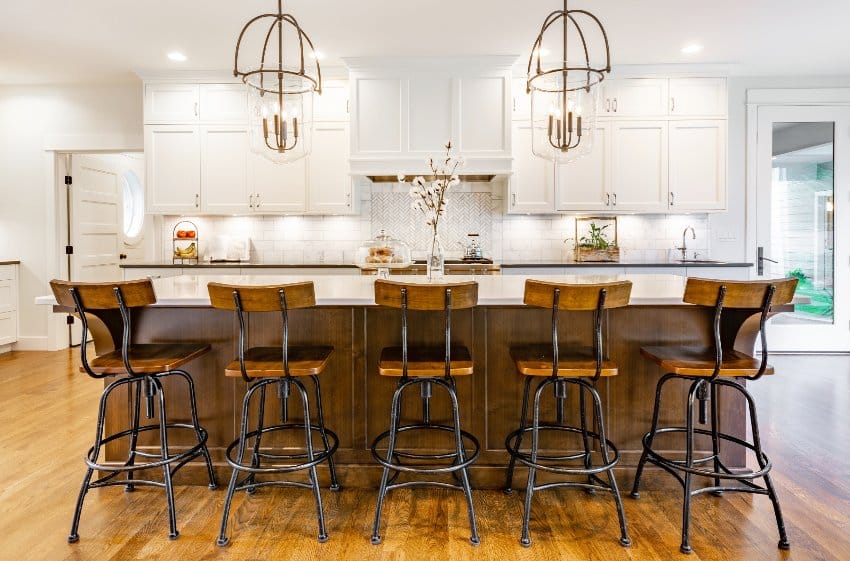
Colonial kitchen furniture showcases straightforward features but displays high craftsmanship while providing that sense of home and comfort that we love about traditional styles.
So, whether it’s from a collective sense of nostalgia or simply a need for a break from the world’s modern sensibilities, colonial kitchen cabinets are the perfect addition to a cozy yet elegant kitchen space.
What Are Colonial Style Kitchen Cabinets?
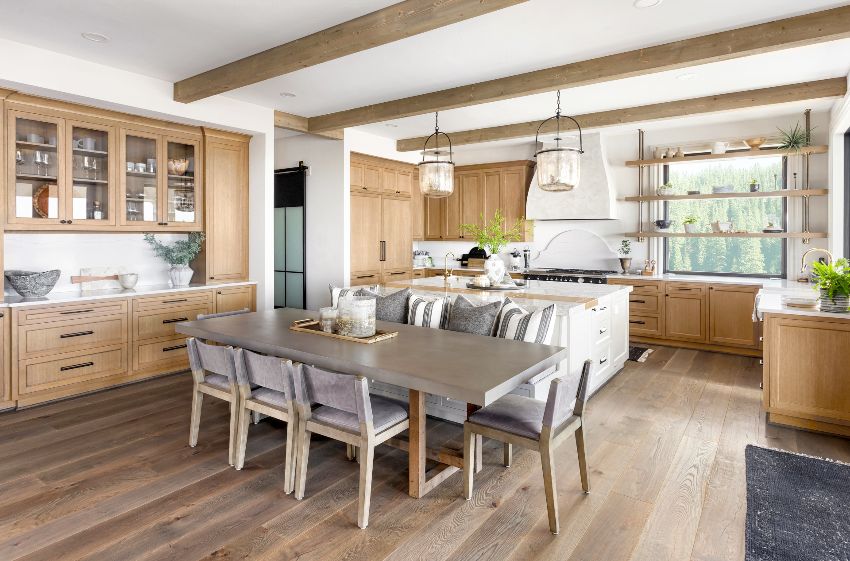
Since the colonial period lasted for 150 years, there are primarily four periods that have produced different kitchen styles. The Colonial style kitchen cabinets mainly feature an elegant and sophisticated aesthetic with practicality and functionality in mind.
The expertly crafted cabinets are traditionally made from hardwood available during the American colonial period, such as maple, pine, cherry, or oak, with mid-toned lumber as the common choice. Hardware is typically made of metal, whereas oil-rubbed bronze is a common match for natural wood.
Traditional kitchen cabinets come in a range of options, with their main character being elegant yet relatively straightforward in design and not overly ornate.
Typically, colonial kitchen cabinets have a shaker-style structure with simple lines that can be conveniently updated with handcrafted motifs. The simple lines also allow the easiness of sanding the cabinets and painting the surface.
Colonial Kitchen Design Characteristics:
• Solid Wood Built
• Period Reproduction Hardware
• Wavy Glass
• Dovetail Drawers
• Beaded Details
• Inset Doors
• Integrated Hidden Appliances
Today, colonial kitchen cabinets used in modern homes tap a plethora of light-colored forefronts with a similar symmetrical and simple design made of a variety of hardwood quality materials.
Colonial Kitchen Design Features

To get an overview of what makes a colonial kitchen design, it is important to note how homes were built during this period. Since transportation was limited during this era, built-in cabinetry made from local wood materials was utilized in combination with adding heirloom pieces.
Tapping from its inspiration, the colonial kitchen features accessories from the Victorian period, such as artisanal pots, pans, and wooden ladles.
Other elements that are common in colonial kitchen designs are integrating a few simple arches and dental molding, which were drawn from the Federal and Georgian architectural styles popular during the colonial period.
Primary Colonial Kitchen Cabinet Features:
• Extensive Use of Solid Wood
• Aesthetic Profile of European Classical Furniture
• Cabinetry Integral in Kitchen Interiors
• Extensive Work Space – Spacious Kitchen Island
• Built-in Cabinetry and Heirloom Pieces
• Natural and Muted Pigments
• Basic Rustic Look (Not too Rustic)
• Hardwood Floors with Oriental Features
• Simple Window Treatments

The spaciousness of colonial kitchens allows the desirable open plan to be functional while providing a visual richness that’s not overwhelming. The extensive space also includes elements such as the kitchen sink, where deep farmhouse sinks are usually integrated to capture that workhorse environment.
Complementing the high-quality materials and providing a breather from the extensive use of wood, granite, and marble are commonly used for the countertop design. Modern touches of tiles and wallpaper with a stencil or toile design are also great in breaking off the solid wood aesthetic.
For floors, colonial kitchens primarily use hardwood but quarried stone such as slate can also provide that grounding effect and allow contrast among the elements.
Colonial Kitchen Cabinet Doors
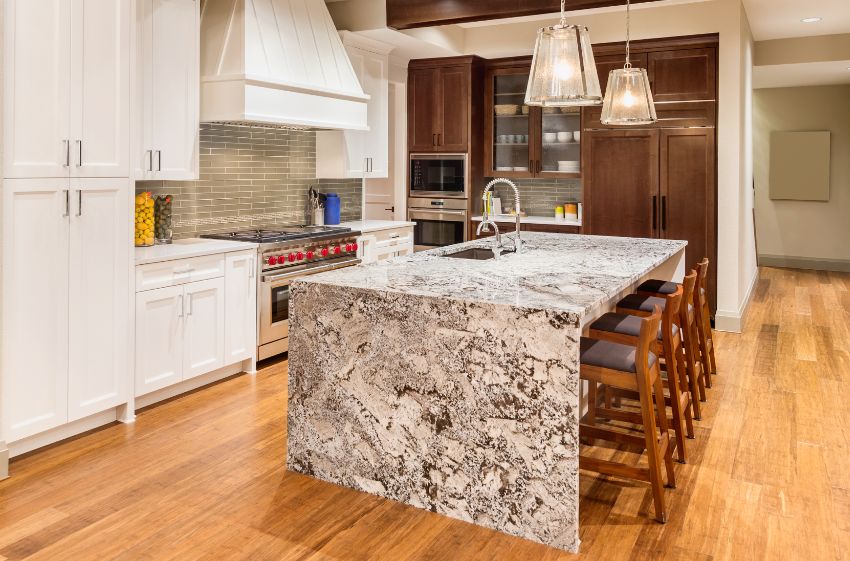
As mentioned, kitchen cabinetry is an integral part of the traditional style, and for this reason, colonial kitchen cabinet doors showcase excellent craftsmanship made from natural hardwood.
The well-crafted cabinet fronts have conservative designs, where subtle details such as beading or high-top arches with raised or flat panels are commonly used. Shaker cabinets are popular, as well as the Georgian aesthetic, primarily with soft and delicate designs with ornate carvings, trims, and arches.
For that authentic classic colonial kitchen, custom wood cabinetry or refaced wood veneers can be used with forged iron cabinet hardware. The most common hardwood used in colonial kitchen cabinet doors is maple, pecan, cherry, or oak, with each bringing a distinct feature.
Common Features:
• Raised panel. These doors have a raised center panel and a recessed border around the edges. This style is often associated with colonial-style kitchens.
• Shaker. These doors have a simple, utilitarian design, a flat center panel, and a recessed border around the edges. They are a classic choice for colonial-style kitchens.
• Beadboard. These doors have a textured surface with vertical grooves, creating a beadboard-like appearance. They can add a rustic touch to a colonial-style kitchen.
• Glass-front. These doors have a clear or frosted glass panel in place of a solid center panel. They can add a touch of elegance to a colonial-style kitchen and also make it easier to see the contents of your cabinets.
Colonial Kitchen Cabinet Hardware

Brass materials are conserved by producing undersized doorknobs. Locks in the 1800s were imported from England, with a few small companies producing crude cast iron rim locks.
The most common hardware designs include:
• H or HL hinges.
• Cast iron pulls.
• Strap hinges.
• Shutter dogs.
• Hand-hammered pieces that give distinctive designs.
• Rosette and fine ribbed details are common designs for knobs.
Today, colonial-style inspired cabinet hardware is available in various finishes with the distinct antique profile of European cabinet hardware designs.
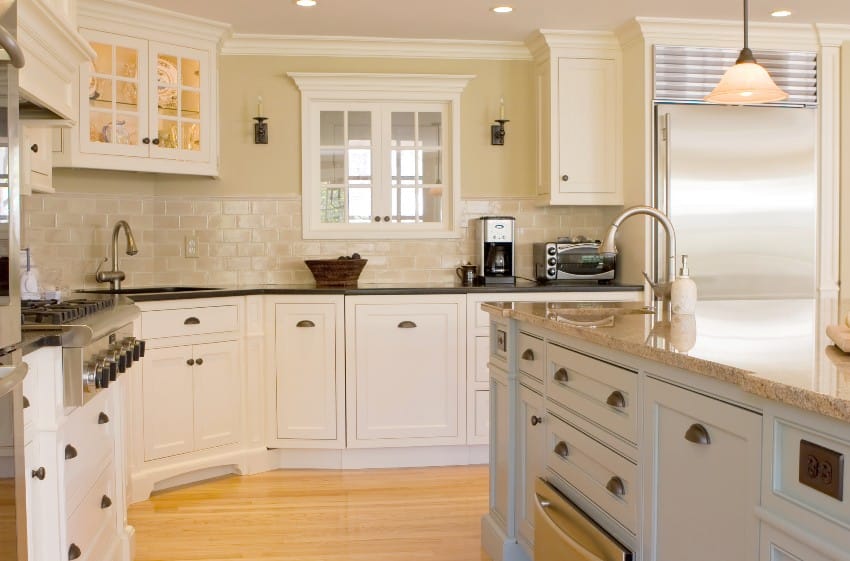
• Drop handles. These are long, decorative handles that are attached to the cabinet doors with screws. They are a classic choice for colonial-style kitchens.
• Knob handles. These are small, round handles that are attached to the cabinet doors with a single screw. They are a simpler option than drop handles and can work well in a colonial-style kitchen.
• Bail handles. These are similar to drop handles but have a curved or “bail” shape. They are a more decorative option that can add a touch of elegance to a colonial-style kitchen.
• Cup handles. These are small handles in the shape of a cup that is attached to the cabinet doors with screws. They are a more understated option that can work well in a colonial-style kitchen.
When choosing colonial-style kitchen cabinet hardware, it’s a good idea to consider the overall style of your kitchen and select handles that will complement the design. Alternatively, handles made of natural materials, such as wood or brass, can add to the colonial feel of the space.
Colonial Kitchen Ideas
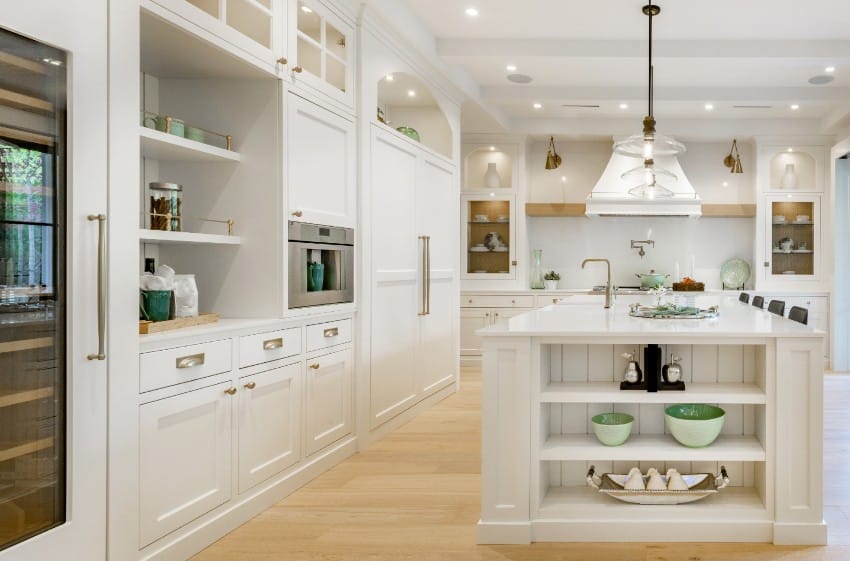
When a kitchen is cut off from a living area due to a large wall, widen and center the passageway instead of knocking down the entire wall. This also allows light and view to continue from room to room.
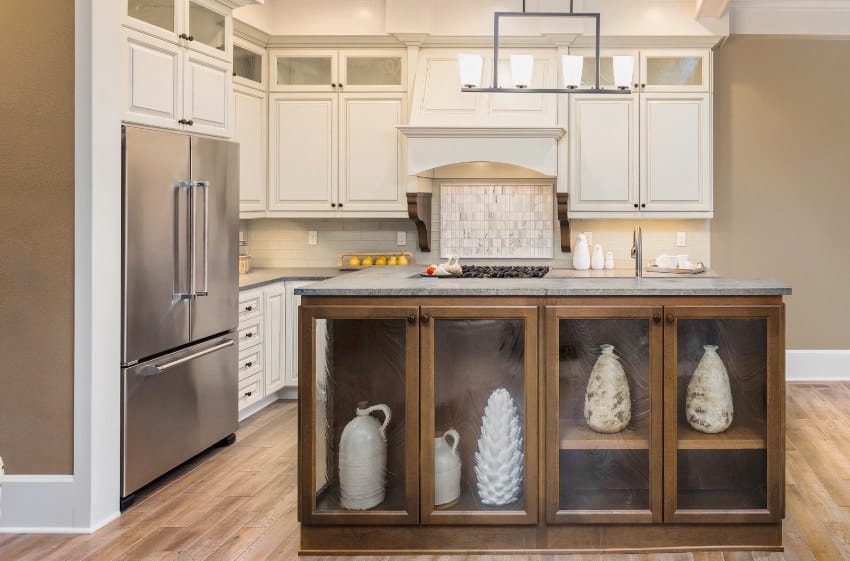
3. Modern Mixes. While brass and cast-iron hardware complete the look of a colonial kitchen cabinet, adding modern hardware with sleek metallic finishes can add an interesting contrast to your traditional lines. Pair with copper, rose gold, or silver to whitewashed colonial-inspired kitchen cabinetry.
4. Stone Countertops. While woodblock slabs are common in the classic colonial kitchen, a light-colored stone countertop works best as it provides a breather from the extensive use of wood. Quartz and marble are common options as they match the elegant sophistication of the traditional style.
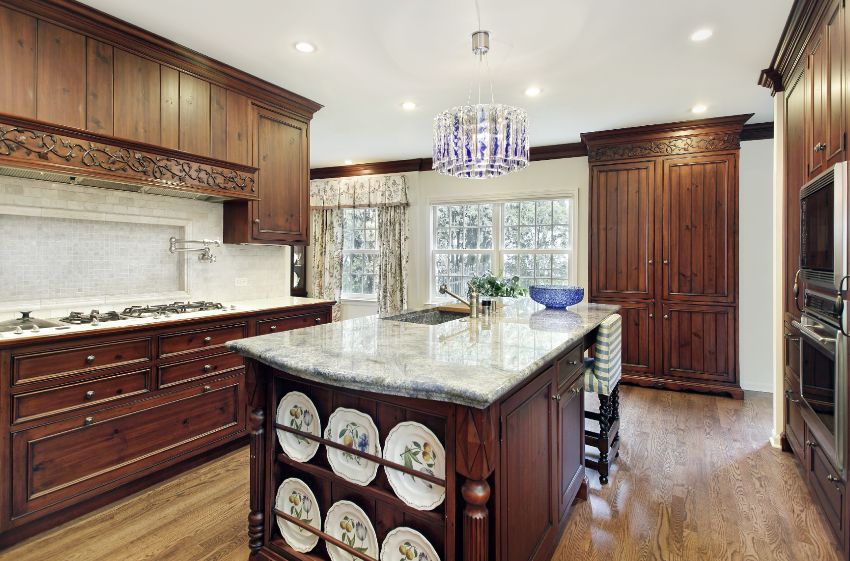
Marble, for instance, is unmatched by its classical beauty but can be a high-maintenance kitchen countertop, not to mention it is expensive compared to quartz.
5. Inset Glass Cabinets. Another way to add a layer of texture to a colonial kitchen is by adding sleek glass. Choose glass for the upper cabinets, and it’s also a practical option as items are easily seen inside. Fogged glass is also a great alternative providing a semi-transparent material that provides level concealment.
6. Add Hardware Backplates. Attention to detail can make a huge difference in a kitchen colonial kitchen. Add a hardware backplate that further enhances the kitchen cabinetry while also being a practical means to hide imperfections on the cabinet surface, especially when the hardware is replaced.
7. Colonial Accessories. Choose furniture and accessories with a colonial or early American flair, such as Windsor chairs, braided rugs, and metal or tin pitchers.

Visit our guide to kitchen colors for brown cabinets for more related content.

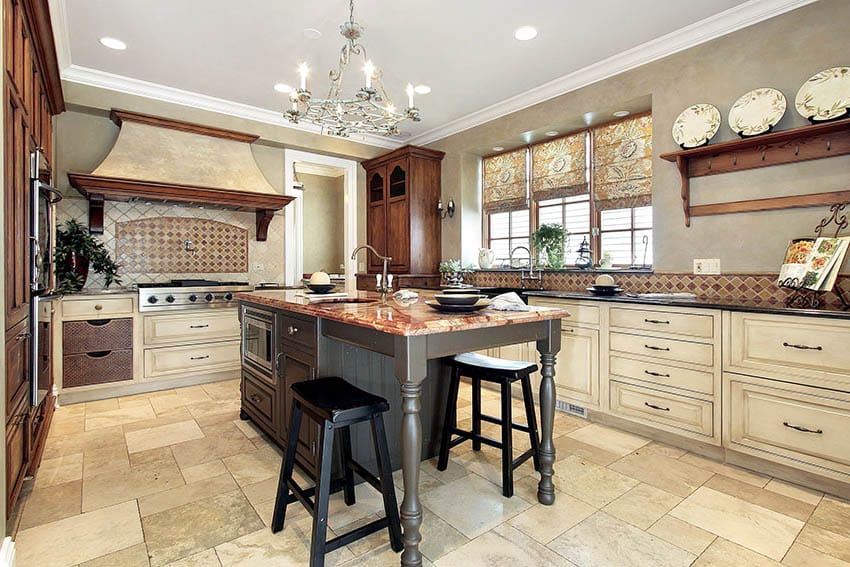




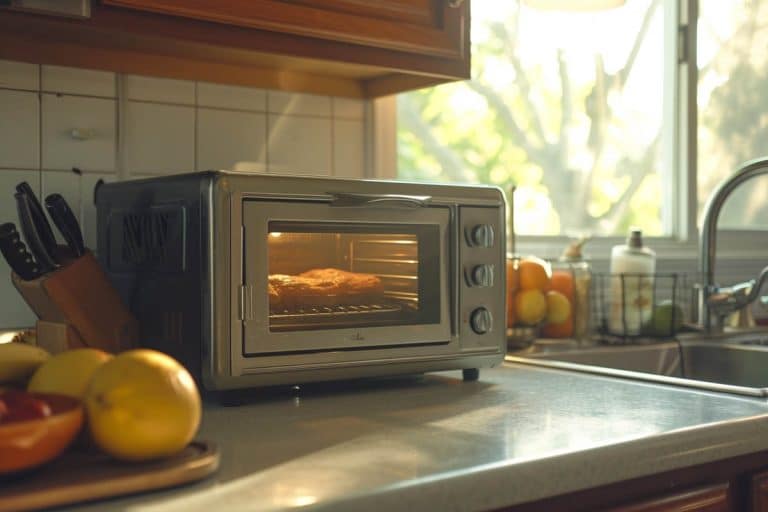

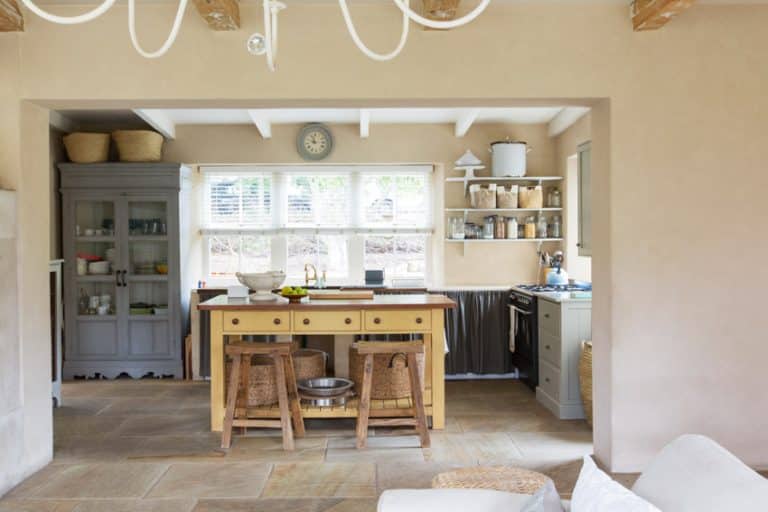
My sister & husband bought an original Dutch colonial house in Maine. It’s on the local historical tour, so certain architectural details cannot be removed, electrified, or changed without permission from the Historical Society. When they bought it, they thought the tall “closet” or cabinet next to the huge almost “walk in” kitchen fireplace was used for storing cooking utensils etc EXCEPT it has no shelves & is brick inside. I thought perhaps it was used to keep food warm or possibly to dry out herbs although whatever would have been inside to “hang”, dry or even COOK in it is no longer there. Not wanting to look like an idiot to the very nice but kind of “ picky” Historical Society, we’ve been looking for explanations for these cabinets ( one tall and one shorter below, again with brick bottoms although it seems SOMETHING has been removed. I suggested bread raising but AGAIN, no specific shelf. We’re also stunned that all information about “Dutch ovens” refers to the actual pot. She has a Lodge she used to use for baking at 500° in her previous house and we both have pieces of cast-iron cookware that we love for certain dishes, that simply don’t come out the same if you try to put them in a modern steel, or enameled large pot. My Grandmother had two enamel pots , one like a large “ dutch oven” pot in which she made while chickens with herbs or a long slow cooking Italian Stew she called “ Christmas stew”
Which she started with pieces of chopped try tip, and then some thing called a “ buttato” ( garlic, salt parsley & a tiny bit olive oil that we’d wstch her chop with a large curved double handed blade over and over until it was a paste. I wish we had been paying more attention.The other enameled pan is a large Orange skillet with the old wooden handle removed. She called these “ Descoware”. I have the large skillet and I make my own version of Chile Relleno ( you stuff Ortega chiles with Jack cheese then coat them with tempura that is kept VERY thick and they’re fried in Canola or better, Grapeseed oil. When turned ANY part not coated has more batter put on it & turned again. I invented this 50 years ago for a Mexican American boyfriend because I didn’t like the soft egg batter on Chile Relleno. You are the first person to see this recipe printed because it was a family secret, but at my age it’s time to give it up! A friend of mine, who is married into a Mexican, American, and family added a line of thick
Cut red salsa on top and even ones wrapped it and it’s your Tia which I think is a little bit too much!) but since I’m hoping you can help us, you deserve the recipe, just please use my name if you make it. I may be older but I’m still vain! I have never made these that people did not LOVE them & and ask what they were. My sweet old Mexican boyfriend love them too and he said “I don’t know what these are, they’re not Chile Relleno , but they sure are good!” I’ve just always called them Chile Relleno Tempura.
Hint: you carefully remove inside stems & seeds from canned WHOLE Ortega chiles, Then you cut the cheese ( not TOO thick) to fit each Chile. Broken Chili’s can be used to because they’re covered totally in the batter.. my sister told me to tell somebody because she doesn’t like to take the time to do them!
Back to the question, what can she do with this cabinet next to the walk-in fireplace that we can’t wait to hang Lodge “ Dutch ovens” over the heavy iron swing inside the fireplace! But it’s July so that isn’t going to happen soon! She decided that she would have an open house in early November for the Society and other neighbors. There’s still a lot of other things that need to be done. There are not actual changes to the architecture. A good bit of paint and wallpaper.! And the floors need to be sanded and refinished.
She told me wryly, no wonder we got a surprisingly low price on this historical house and agreeing to keep it very much to it’s old state.
Neither one of us like a lot of counter doodads and hate microwaves, but now GE has a countertop oven that does eight things! It’s remarkable! No need for an actual bend down oven anymore & the washer/dryer is one piece that does the whole thing although you have to wait so it’s not good for small loads. But they have found some very clever ways to disguise these marvels of today. The dishwasher has a wooden cutting board that goes over and down to the floor, but it is hinged so you can get into it. ( My brilliant cousin!) the washer dryer is going to be covered with a quilt and a tureen or tea pots on top! They have no children home anymore so they’re not going to be doing as much laundry!) and my cousin is coming up with an idea to cover the GE countertop oven without making it difficult to get to it. Because it’s used for toast in the morning, frittatas, convection, cooking, regular baking and my sister likes things to go in the oven so she doesn’t have a rangetop mess. The “ range top” are convenient one pan induction plates that she keeps in the cupboard underneath and only pulls out what she needs! Yeah, you wanna move in don’t you? So do I!!! But again, we come back to the fact that when she has her housewarming, she wants to be using that cabinet next to the fireplace for its best use, and make nothing of it, so the picky ladies ( they really are nice) can’t say “ oh dear! That’s not how you use a Dutch oven cabinet!”
I know I write too long. But I am exhausted from the search. I suppose I could actually have gotten in the car and gone to a library, but for all I know, books on old Dutch ovens have been “banned”. Excuse my snide political sense of humor.!
At any rate, I hope you have a really good answer!!!! we are both loving getting this house in sparkling shape while retaining it’s old charm.
I have insisted that my husband and I get to spend a month there at Christmas time and she can entertain the kids and the grandkids! I’ve always been the one to do it and I’m pretty sick of it.
You stay up the night before assembling toy, get up early and start cooking( although the table is set, and we eat out the night before!) and after everybody is full and dozing from the excellent wine, my daughter brings. She actually doesn’t drink very much but she’s a sommelier! Very very handy to have one in the family! But after the whole thing is over, I am the one who has to clean up even with “help” ( aunt Maggie where does this go? “ can’t we just soak them and leave them overnight” ) I fell for that once and got up the next morning and had to clean everything!!! so we are happy to help with this house! My husband is finally retiring. I already am retired, and I will enjoy so much bringing our to Irish setters and letting them tear around the huge backyard. For a WHOLE MONTH!!! I couldn’t have designed a better vacation!
G-d bless you for helping us out I have a feeling you are the ONE!
And remember, It’s Maggie Elfman’s Chile Relleno Tempura! Just in case somebody really likes it and feels like writing a cookbook!!!
Have a lovely week! We are obviously patient people, and there’s so much to do that. I am sure the detail of the Dutch oven cabinet can be handled easily once we know what the heck to do with it!!! And this week, we are going to visit my daughter and son-in-law and new twin grand children in Southern California, where they don’t have mosquitoes!!!!
MUCH THANKS!
Maggie Elfman
Your sister’s charming Dutch Colonial house sounds like a real hidden gem! I love the idea of giving new life to a home steeped in history. The tall, mysterious cabinet next to the kitchen fireplace seems especially intriguing.While its original purpose is unclear, here are some likely possibilities based on common designs in historical homes:
A Warming Cabinet – This would explain the brick lining—perfect for retaining heat from the adjacent fireplace to keep food piping hot.
A Drying Cabinet – The warm, ventilated interior could have been used to dry herbs or meat. Items may have hung from hooks along the back wall.
A Bread Proofing Box – The consistent warmth from the fireplace would have made it an ideal spot for dough to rise.
Simple Storage – It may have held firewood or other supplies, with the brick walls and flooring for fire safety.
Given the preservation requirements, here are some ways to respectfully utilize this unique feature:
– Display antique cookware or utensils.
– Add removable hooks for drying herbs or proofing bread.
– Place attractive baskets inside for kitchen item storage.
Most importantly, highlight the cabinet’s history and intrigue when you host the November housewarming. Create an informational card explaining the possibilities behind this architectural anomaly! It will show guests and the Historical Society your appreciation for the home’s one-of-a-kind details. Thank you for the heartwarming message and the recipe sounds delicious.